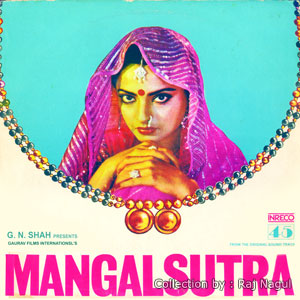Raat Banoon Main Aur Chaand Bano Tum

Film: Mangalsutra (1980)
Singers: Bhupinder Singh and Asha Bhosle
Lyricist: Nida Fazli
Producer: Ravi Kumar
Director: B. Vijay
Creating a mood for the song is like half the battle won for any music director and sustaining it throughout the song and taking it to the crescendo is the other half. Both the Dev Burmans excelled in this – in fact, it was their forte. No wonder each of their creations touched the heart of the listener instantly and stayed there forever.
As beautifully explained by Late Shri Anand Modak in one of the panchammagic shows, the core of their songs was the bhaav-tatva, the mood-creator. Sachin Dev Burman followed this trend and Pancham carried forward that baton beautifully.
A major chunk of Hindi film music has been the romantic songs and no ambiance suits more than the night preferably illuminated by the lunar rock – chaand. There are also some virah-geets and loris that use the same ambiance. The Burmans have used a near-trademark instrumental phrase of guitar strums coupled by some elastically stretched reso reso or a maracas, be it in “Rulake gaya sapna mera” (Jewel Thief) or in the loris “Chanda o chanda” (Lakhon Mein Ek), “Phoolon ka taaron ka” (Hare Rama Hare Krishna) or “Ek din hansaana” (Benaam). Even consider the hugely popular “Pyar tumhein kis mod pe” (Satte Pe Satta), which travels from a gloomy dusk to the violent late-night adventure. The guitar–reso reso combo in the slow half is a near signature tune. Play that portion anywhere and the listener will instantly identify the song.
Pancham had a very close associate, a friend in fact, who illuminated these songs with his vibrant and innovative playing of the guitar. Yes, I am talking about Bhupindermaan Singh, popularly known as Bhupendra, Bhupinder or Bhupi-ji among his fans. He is an all-round personality who could sing with a unique voice and also play many instruments other than the guitar with equal skill. Bhupi-ji is more popular for his ghazals or ghazal-type songs but trust Pancham to use him in various kinds of songs – for example, the carefree friendship choral “Yaaron hamara kya” (Abhilasha) or pure classical songs like “Beeti na beetai,” “Mitwa bole meethe bain” (both from Parichay), “Koi nahin hai kaheen” and “Meethe bol bole” (both from Kinara). He even used him to give just a vocal harmony to Asha Bhosle in “Jab andhera hota hai” (Raja Rani) and to add zing to the chorus in “Raah mein kaliyan”(Nafrat). Pancham also used him for the voice-over-voice experiment in “Yeh zindagi hai chaar pal” (Savera), which was unique in the male singer category.
The song in the context of this write-up is a sensually romantic night song from Mangalsutra that is illuminated by both the trademark Burman guitar phrases and golden singing by Bhupinder along with the ever youthful and romantic Asha Bhosle. The song is all about a newly-wed couple desiring for intimacy on a leisurely night. The start is obviously done by the husband, and the mood is instantly created by a smooth and almost ad-lib entry by Bhupi-ji’s sensual humming and the guitar strumming wrapped by a flute, expressing the urge “aao baahon mein aao” musically. This ensures a perfect landing on the mukhda. Bhupi-ji’s quintessential voice then takes over to express the urge lyrically. His unique touch can be felt at “chaand<banoon main>” or along the high point “aao baahon mein aao.” The whole aaroh (ascent) follows with a kissing sound.
Who else, but Pancham, would think of such a fitting effect and place it immaculately like this!
The repeat of the mukhda line has the violins getting livened up and more rhythmic. The crescendo again kisses the effect. The first interlude carries a beautiful and passionate mix of the strums, flute and the moving violins that’s wrapped by a strumming pattern that’s again so reminiscent of a similar strumming in a Satte Pe Satta song.
The antara has a similar pattern of ascent like the mukhda but ever so gentle with a lovely rhythmic roll before the repeat of the antara lines. This is another place in Pancham songs that is so beautifully crafted with the touch of masterly innovation. The repeat then is followed by a high-pitched and a busy-metered crossover. Pancham this time denies the listener in the kis(s) ka rasta dekhe state but solaces him/her with the entry of sweet Asha singing for a sensual Rekha on-screen.
The mukhda rendition in her voice sounds even more magical and that “aao baahon mein aao” is more sensual and inviting. The kiss adds more air to the desiring flame.
The second antara shuffles the instrumentals of mandolin, guitar, flute and punctuating violins to present a different kaleidoscopic pattern. The same urging flute gives way to Asha’s soothing and more open-voiced humming that makes you feel the ruffling of the nylon curtains by the cool breeze of the night. If you wondered about Asha’s rather plain entry after the recent crossover, here is Pancham’s answer. He delayed that delight by placing it here. Very cute of you, Pancham.
The second antara is all Asha, with Bhupinder re-entering the song at the crossover with Asha giving harmony. The nice and leisurely entry of the accordion in the final interlude makes the progression interestingly longing. The mandolin does a nice duet with it and the usual elements of the flute and the wrapping strumming effect lead to the final antara.
A usual progression with the vocal threads of the singers winding around each other ends with an appropriate fade-out with the hinting intimacy.
Indeed what a friendship and collaboration of genius personalities called Bhupi-ji , Pancham and Asha-ji, complementing each other just like “raat banoon main aur chaand bano tum”!
My humble tribute to all.
Sudhir Kulkarni
panchammagic.org

